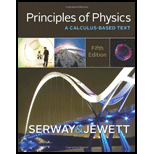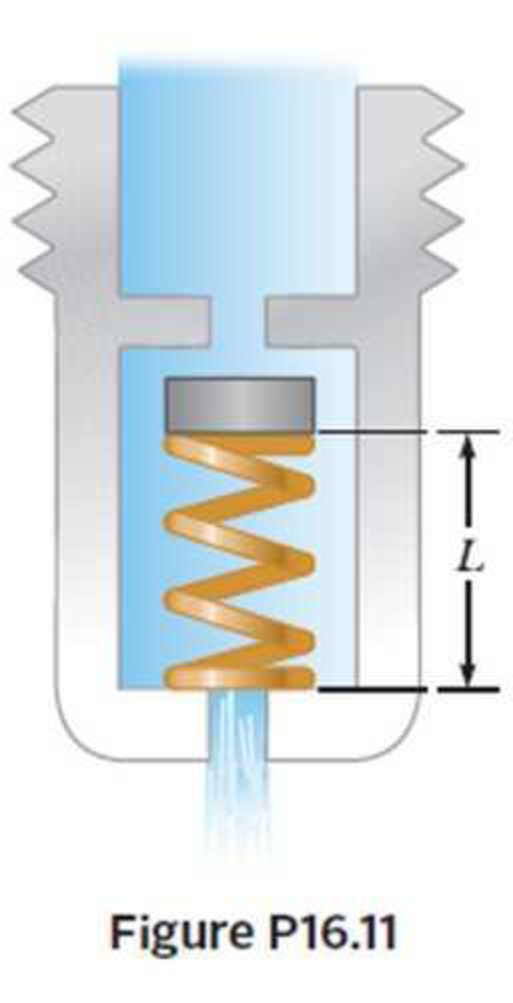
Concept explainers
Each year thousands of children are badly burned by hot tap water. Figure P16.11 shows a cross-sectional view of an antiscalding faucet attachment designed to prevent such accidents. Within the device, a spring made of material with a high coefficient of thermal expansion controls a movable plunger. When the water temperature rises above a preset safe value, the expansion of the spring causes the plunger to shut off the water flow. Assuming that the initial length L of the unstressed spring is 2.40 cm and its coefficient of linear expansion is 22.0 × 10–6 (°C)–1, determine the increase in length of the spring when the water temperature rises by 30.0°C. (You will find the increase in length to be small. Therefore, to provide a greater variation in valve opening for the temperature change anticipated, actual devices have a more complicated mechanical design.)

Want to see the full answer?
Check out a sample textbook solution
Chapter 16 Solutions
Bundle: Principles of Physics: A Calculus-Based Text, 5th + WebAssign Printed Access Card for Serway/Jewett's Principles of Physics: A Calculus-Based Text, 5th Edition, Multi-Term
- Q: You have a CO2 laser resonator (λ = 10.6 μm). It has two curved mirrors with R₁=10m, R2= 8m, and mirror separation /= 5m. Find: R2-10 m tl Z-O 12 R1-8 m 1. Confocal parameter. b= 21w2/2 =√1 (R1-1)(R2-1)(R1+R2-21)/R1+R2-21) 2. Beam waist at t₁ & t2- 3. Waist radius (wo). 4. 5. The radius of the laser beam outside the resonator and about 0.5m from R₂- Divergence angle. 6. Radius of curvature for phase front on the mirrors R₁ & R2-arrow_forwardNo chatgpt pls will upvotearrow_forwardSARET CRKS AUTOWAY 12. A stone is dropped from the top of a cliff. It is seen to hit the ground below after 3.55 s. How high is the cliff? 13. A ball is dropped from rest at the top of a building that is 320 m tall. Assuming no air resistance, what is the speed of the ball just before it strikes the ground? 14. Estimate (a) how long it took King Kong to fall straight down from the top of the Empire State Building (280m high), and (b) his velocity just before "landing". Useful equations For Constant Velocity: V => D X = V₁t + Xo For Constant Acceleration: Vr = V + at X = Xo+Vot + v=V+2a(X-Xo) \prom = V +V V velocity t = time D Distance X = Final Position Xo Initial Position V = Final Velocity Vo Initial Velocity a = acceleration For free fall Yf = Final Position Yo Initial Position g = 9.80 m $2 For free fall: V = V + gt Y=Yo+Vo t + +gt V,² = V₁²+2g (Y-Yo) V+Vo Vprom= 2 6arrow_forward
- Solve the problemsarrow_forwardA 11 kg weight is attached to a spring with constant k = 99 N/m and subjected to an external force F(t) =-704 sin(5t). The weight is initially displaced 4 meters above equilibrium and given an upward velocity of 5 m/s. Find its displacement for t> 0. y(t) וןarrow_forward7. A race car accelerates from rest to 55 m s-1 in 5.0 seconds. The acceleration of the car Is m s-² 8. An object's speed increases uniformly from 10.5 km per hour to 99.8 km per hour in 2.41 seconds. Calculate the acceleration in m s-2 and express your answer to three significant figures. 9. The acceleration-time graph of a car is shown below. The initial speed of the car is 5.0 m s-1. # Acceleration (ms) 12 8.0- 4.0- 2.0 4.0 6.0 Time (s) Calculate the velocity of the car at t = 4.0 s. 3arrow_forward
- No chatgpt pls will upvotearrow_forwardNo chatgpt pls will upvotearrow_forwardProblem Seven. A football receiver running straight downfield at 5.60 m/s is 11.5 m in front of the quarterback when a pass is thrown downfield at an angle of 35.0° horizon. above the 8.) If the receiver never changes speed and the ball is caught at the same height from which it was thrown, find the distance between the quarterback and the receiver when the catch is made. (A) 21.3 (B) 17.8 (C) 18.8 (D) 19.9 (E) 67.5arrow_forward
 Principles of Physics: A Calculus-Based TextPhysicsISBN:9781133104261Author:Raymond A. Serway, John W. JewettPublisher:Cengage Learning
Principles of Physics: A Calculus-Based TextPhysicsISBN:9781133104261Author:Raymond A. Serway, John W. JewettPublisher:Cengage Learning Physics for Scientists and EngineersPhysicsISBN:9781337553278Author:Raymond A. Serway, John W. JewettPublisher:Cengage Learning
Physics for Scientists and EngineersPhysicsISBN:9781337553278Author:Raymond A. Serway, John W. JewettPublisher:Cengage Learning Physics for Scientists and Engineers with Modern ...PhysicsISBN:9781337553292Author:Raymond A. Serway, John W. JewettPublisher:Cengage Learning
Physics for Scientists and Engineers with Modern ...PhysicsISBN:9781337553292Author:Raymond A. Serway, John W. JewettPublisher:Cengage Learning Physics for Scientists and Engineers: Foundations...PhysicsISBN:9781133939146Author:Katz, Debora M.Publisher:Cengage Learning
Physics for Scientists and Engineers: Foundations...PhysicsISBN:9781133939146Author:Katz, Debora M.Publisher:Cengage Learning Physics for Scientists and Engineers, Technology ...PhysicsISBN:9781305116399Author:Raymond A. Serway, John W. JewettPublisher:Cengage Learning
Physics for Scientists and Engineers, Technology ...PhysicsISBN:9781305116399Author:Raymond A. Serway, John W. JewettPublisher:Cengage Learning





